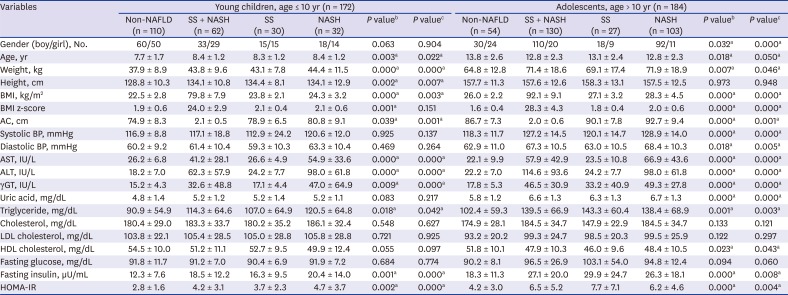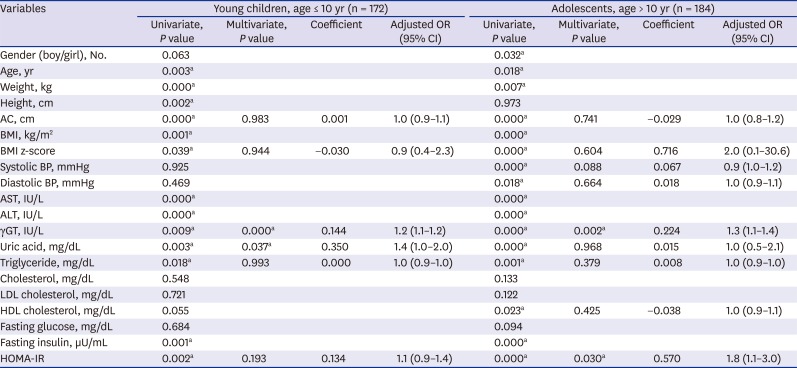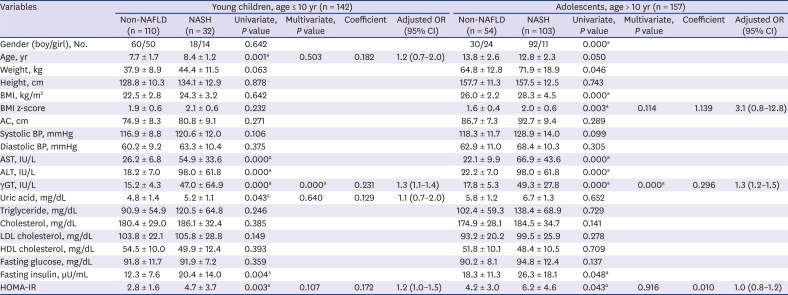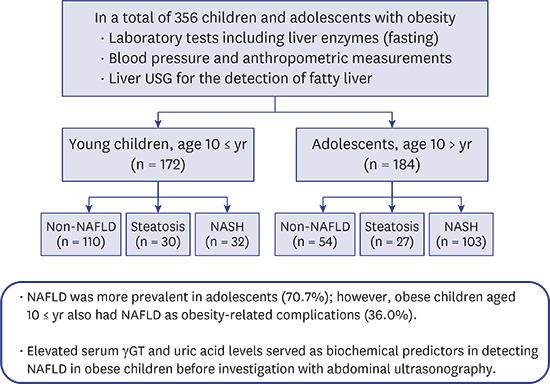1. Kang KS. Nutritional counseling for obese children with obesity-related metabolic abnormalities in Korea. Pediatr Gastroenterol Hepatol Nutr. 2017; 20(2):71–78. PMID:
28730130.
2. Patton HM, Sirlin C, Behling C, Middleton M, Schwimmer JB, Lavine JE. Pediatric nonalcoholic fatty liver disease: a critical appraisal of current data and implications for future research. J Pediatr Gastroenterol Nutr. 2006; 43(4):413–427. PMID:
17033514.
3. Vajro P, Lenta S, Socha P, Dhawan A, McKiernan P, Baumann U, et al. Diagnosis of nonalcoholic fatty liver disease inchildren and adolescents: position paper of the ESPGHAN Hepatology Committee. J Pediatr Gastroenterol Nutr. 2012; 54(5):700–713. PMID:
22395188.
4. Yang HR, Yi DY, Choi HS. Comparison between a pediatric health promotion center and a pediatric obesity clinic in detecting metabolic syndrome and non-alcoholic fatty liver disease in children. J Korean Med Sci. 2014; 29(12):1672–1677. PMID:
25469068.
5. Koot BG, van der Baan-Slootweg OH, Bohte AE, Nederveen AJ, van Werven JR, Tamminga-Smeulders CL, et al. Accuracy of prediction scores and novel biomarkers for predicting nonalcoholic fatty liver disease in obese children. Obesity (Silver Spring). 2013; 21(3):583–590. PMID:
23592667.
6. Manco M, Alisi A, Nobili V. Risk of severe liver disease in NAFLD with normal ALT levels: a pediatric report. Hepatology. 2008; 48(6):2087–2088. PMID:
18980229.
7. Matteoni CA, Younossi ZM, Gramlich T, Boparai N, Liu YC, McCullough AJ. Nonalcoholic fatty liver disease: a spectrum of clinical and pathological severity. Gastroenterology. 1999; 116(6):1413–1419. PMID:
10348825.
8. Alberti KG, Zimmet PZ. Definition, diagnosis and classification of diabetes mellitus and its complications. Part 1: diagnosis and classification of diabetes mellitus provisional report of a WHO consultation. Diabet Med. 1998; 15(7):539–553. PMID:
9686693.
9. Marchesini G, Brizi M, Bianchi G, Tomassetti S, Bugianesi E, Lenzi M, et al. Nonalcoholic fatty liver disease: a feature of the metabolic syndrome. Diabetes. 2001; 50(8):1844–1850. PMID:
11473047.
10. Vos MB, Abrams SH, Barlow SE, Caprio S, Daniels SR, Kohli R, et al. NASPGHAN clinical practice guideline for the diagnosis and treatment of nonalcoholic fatty liver disease in children: recommendations from the Expert Committee on NAFLD (ECON) and the North American Society of Pediatric Gastroenterology, Hepatology and Nutrition (NASPGHAN). J Pediatr Gastroenterol Nutr. 2017; 64(2):319–334. PMID:
28107283.
11. Sartorio A, Del Col A, Agosti F, Mazzilli G, Bellentani S, Tiribelli C, et al. Predictors of non-alcoholic fatty liver disease in obese children. Eur J Clin Nutr. 2007; 61(7):877–883. PMID:
17151586.
12. Wan YP, Xu RY, Fang H, Lu LP, Zhang XM, Cai W. The prevalence of non-alcoholic fatty liver disease and its related risk factors in 1180 school children in Shanghai. Zhonghua Gan Zang Bing Za Zhi. 2007; 15(9):644–648. PMID:
17903363.
13. Joung KH, Chung SS, Cho SC. Predictors of growth in children based on 2007 Korean National Growth Charts. Pediatr Int. 2011; 53(6):832–838. PMID:
21518126.
14. Matthews DR, Hosker JP, Rudenski AS, Naylor BA, Treacher DF, Turner RC. Homeostasis model assessment: insulin resistance and beta-cell function from fasting plasma glucose and insulin concentrations in man. Diabetologia. 1985; 28(7):412–419. PMID:
3899825.
15. Grundy SM, Cleeman JI, Daniels SR, Donato KA, Eckel RH, Franklin BA, et al. Diagnosis and management of the metabolic syndrome: an American Heart Association/NationalHeart, Lung, and Blood Institute scientific statement: executive summary. Crit Pathw Cardiol. 2005; 4(4):198–203. PMID:
18340209.
16. Bril F, Ortiz-Lopez C, Lomonaco R, Orsak B, Freckleton M, Chintapalli K, et al. Clinical value of liver ultrasound for the diagnosis of nonalcoholic fatty liver disease in overweight and obese patients. Liver Int. 2015; 35(9):2139–2146. PMID:
25847730.
17. Kleiner DE, Brunt EM, Van Natta M, Behling C, Contos MJ, Cummings OW, et al. Design and validation of a histological scoring system for nonalcoholic fatty liver disease. Hepatology. 2005; 41(6):1313–1321. PMID:
15915461.
18. Strauss S, Gavish E, Gottlieb P, Katsnelson L. Interobserver and intraobserver variability in the sonographic assessment of fatty liver. AJR Am J Roentgenol. 2007; 189(6):W320-3. PMID:
18029843.
19. Mencin AA, Lavine JE. Nonalcoholic fatty liver disease in children. Curr Opin Clin Nutr Metab Care. 2011; 14(2):151–157. PMID:
21178608.
20. Kim JS. The role of inflammatory mediators in the pathogenesis of nonalcoholic fatty liver disease. Pediatr Gastroenterol Hepatol Nutr. 2012; 15(2):74–78.
21. Lee KH. Update on non-alcoholic fatty liver disease in children. Korean J Pediatr Gastroenterol Nutr. 2009; 12(Suppl 1):S62–S71.
22. Jee SJ, Kim YJ, Song SY, Paik SS. Association among histopathology, clinical manifestation, and ultrasonographic grades in pediatric non-alcoholic fatty liver disease. Korean J Gastroenterol. 2011; 57(3):158–165. PMID:
21519163.
23. Hossain N, Afendy A, Stepanova M, Nader F, Srishord M, Rafiq N, et al. Independent predictors of fibrosis in patients with nonalcoholic fatty liver disease. Clin Gastroenterol Hepatol. 2009; 7(11):1224–1229. 1229.e1–1229.e2. PMID:
19559819.
24. Kinugasa A, Tsunamoto K, Furukawa N, Sawada T, Kusunoki T, Shimada N. Fatty liver and its fibrous changes found in simple obesity of children. J Pediatr Gastroenterol Nutr. 1984; 3(3):408–414. PMID:
6737186.
25. Schwimmer JB, Dunn W, Norman GJ, Pardee PE, Middleton MS, Kerkar N, et al. SAFETY study: alanine aminotransferase cut off values are set too high for reliable detection of pediatric chronic liver disease. Gastroenterology. 2010; 138(4):1357–1364. 1364.e1–1364.e2. PMID:
20064512.
26. Yang HR, Kim HR, Kim MJ, Ko JS, Seo JK. Noninvasive parameters and hepatic fibrosis scores in children with nonalcoholic fatty liver disease. World J Gastroenterol. 2012; 18(13):1525–1530. PMID:
22509085.
27. Lonardo A, Loria P, Leonardi F, Borsatti A, Neri P, Pulvirenti M, et al. Fasting insulin and uric acid levels but not indices of iron metabolism are independent predictors of non-alcoholic fatty liver disease. A case-control study. Dig Liver Dis. 2002; 34(3):204–211. PMID:
11990393.
28. Tahan V, Canbakan B, Balci H, Dane F, Akin H, Can G, et al. Serum gamma-glutamyltranspeptidase distinguishes non-alcoholic fatty liver disease at high risk. Hepatogastroenterology. 2008; 55(85):1433–1438. PMID:
18795706.
29. Donnelly KL, Smith CI, Schwarzenberg SJ, Jessurun J, Boldt MD, Parks EJ. Sources of fatty acids stored in liver and secreted via lipoproteins in patients with nonalcoholic fatty liver disease. J Clin Invest. 2005; 115(5):1343–1351. PMID:
15864352.
30. de Oliveira EP, Burini RC. High plasma uric acid concentration: causes and consequences. Diabetol Metab Syndr. 2012; 4:12. PMID:
22475652.







 PDF
PDF Citation
Citation Print
Print




 XML Download
XML Download